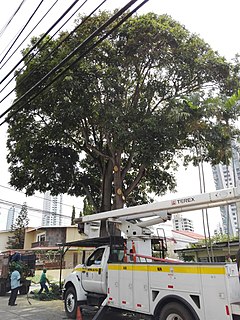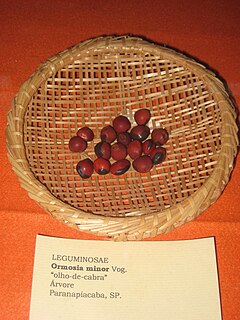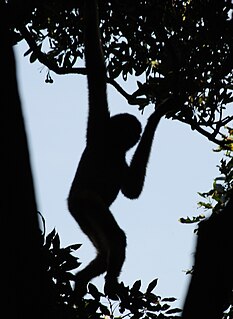
Pinus armandii, the Armand pine or Chinese white pine, is a species of pine native to China, occurring from southern Shanxi west to southern Gansu and south to Yunnan, with outlying populations in Anhui. It grows at altitudes of 2200–3000 m in Taiwan, and it also extends a short distance into northern Burma. In Chinese it is known as "Mount Hua pine" (华山松).

The Hainan hare is a hare endemic to Hainan Island, China. The species was first described by Robert Swinhoe in 1870.

Dalbergia odorifera, or fragrant rosewood, Chinese rosewood, is a species of legume in the family Fabaceae. It is a small or medium-sized tree, 10–15 metres (33–49 ft) tall. It is endemic to China and occurs in Fujian, Hainan, Zhejiang, and Guangdong.

Dalbergia tonkinensis is a species of legume in the family Fabaceae. It is a small tree, 5–13 metres (16–43 ft) tall, found in Hainan Island of China and Vietnam. It is threatened by habitat loss and overexploitation for timber.

Ormosia cruenta is a species of legume in the family Fabaceae. It is found in Panama and Costa Rica.

Ormosia is a genus of legumes. The more than 100 living species, mostly trees or large shrubs, are distributed throughout the tropical regions of the world, some extending into temperate zones, especially in East Asia. A few species are threatened by habitat destruction, while the Hainan Ormosia is probably extinct already.
Ormosia hosiei is a species of legume in the family Fabaceae.
Ormosia jamaicensis is a species of legume in the family Fabaceae. It is found only in Jamaica.
Ormosia panamensis, commonly known as coronil or sur espino, is a species of legume in the family Fabaceae. It is found in Costa Rica, Guatemala, Mexico, and Panama.
Ormosia polita is a species of legume in the family Fabaceae. It is a tree endemic to Peninsular Malaysia. It is threatened by habitat loss.
Podocarpus annamiensis is a species of conifer in the family Podocarpaceae. It is found on Hainan Island of China and in Myanmar and Vietnam. It is threatened by habitat loss.

The Hainan partridge is a species of bird in the family Phasianidae. It is endemic to Hainan Island, China. Its natural habitats are primary evergreen forests. It is threatened by habitat loss and has been assessed as a vulnerable species.

The Chinese stripe-necked turtle or golden thread turtle, is a species of turtle in the family Geoemydidae.

Euonymus cochinchinensis is a tree of tropical Asia in the staff vine family Celastraceae. The specific epithet cochinchinensis refers to the species being native to Indo-China.
Gmelina hainanensis is a species of tree in the family Lamiaceae. It is a medium-sized tree, up to 15 metres (49 ft) tall, growing on open grassy hillsides and sparse forests. It is found in southern China and in Vietnam.
Hopea exalata is a species of tree in the family Dipterocarpaceae. It is endemic to Hainan Island in southern China and enjoys second-class national protection. Some authors consider H. exalata as a junior synonym of Hopea reticulata that is also known from Vietnam.
Hopea reticulata is a species of tree in the family Dipterocarpaceae. It is found in Thailand and Vietnam. Some authors include Hopea exalata of Hainan, China to this species.
Phoebe bournei is a species of tree up to 20 metres (66 ft) tall in the family Lauraceae. It is endemic to China, where it occurs in Fujian, Guangdong, Guangxi, Guizhou, Hainan, Hubei, and Jiangxi provinces. It is threatened by habitat loss. The species is under second-class national protection in China.

The Hainan black-crested gibbon or Hainan gibbon, is a Critically Endangered species of gibbon found only on Hainan Island, China. It was formerly considered a subspecies of the eastern black crested gibbon from Hòa Bình and Cao Bằng provinces of Vietnam and Jingxi County in Guangxi Zhuang Autonomous Region, China. Molecular data, together with morphology and call differences, suggest it is a separate species. Its habitat consists of broad-leaved forests and semi-deciduous monsoon forests. It feeds on ripe, sugar-rich fruit, such as figs and, at times, leaves, and insects.
The Hainan peacock-pheasant is an endangered bird that belongs to the pheasant family Phasianidae. It is endemic to the island of Hainan, China. It is extremely rare.










